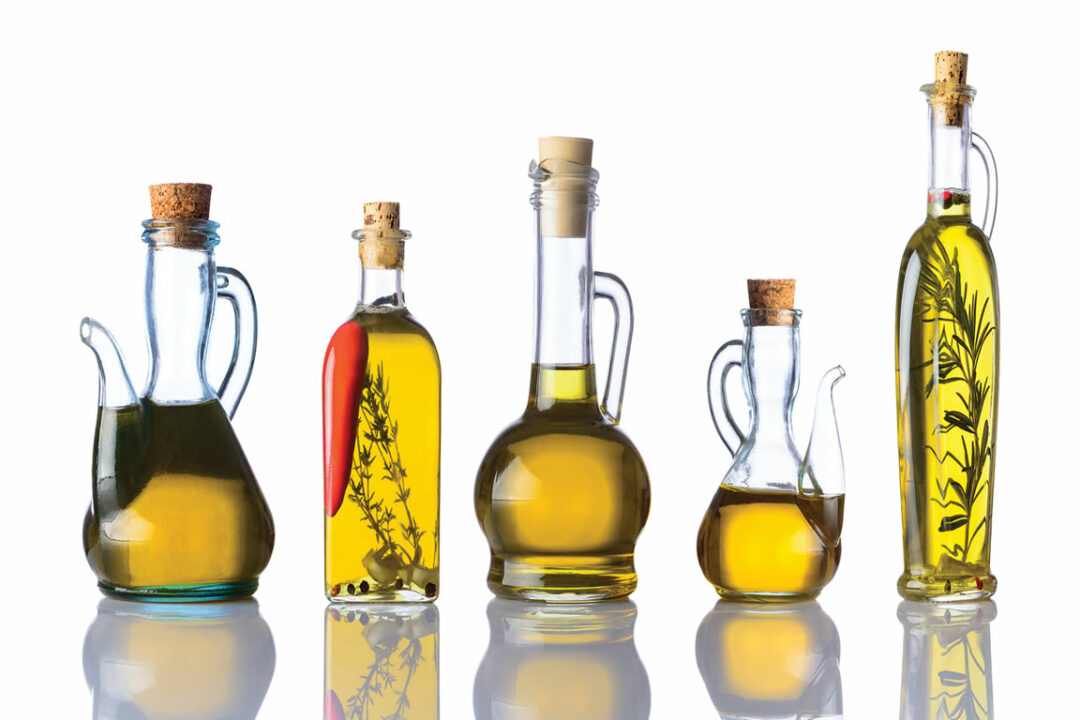They are everywhere — culinary oils are trending on cooking blogs, magazines and shows. Where once mainstream supermarkets pretty much offered not many more choices than Wesson cooking oil, even these shelves are now sporting artisanal and gourmet oils.
“Years ago, most people only thought of olive oil or canola oil to cook with,” emphasizes Debbie Shandel, executive vice president, CMO of Carrington Farms, Closter, NJ. “Now, there are many more options out there.”
There are several factors that are luring consumers to delicious and good-for-you cooking oils.
According to Mark Brooks, senior vice president of food ingredients at San Francisco, CA-based TerraVia, health-conscious consumers are choosing oils that are sources of good fats. Consumer perception about dietary fats have changed noticeably due to what he deems as “significant strides” in fatty acid research. Further, experts and clinicians have dismissed the once-popular “low-fat” food trend, which ignored benefits of fatty acids, and now experts agree that we should all be eating more good fats. For example, Brooks points out, the 2015-2020 Dietary Guidelines for Americans emphasize optimizing types of dietary fats and not reducing total fat, as well as specifically recommending replacing saturated fat with monounsaturated fats. “Consumers are listening to and embracing this ‘good fat’ mentality, especially when it comes to culinary oils,” he says.
Culinary oils are trending with consumers, who are embracing specialty oil, such as sesame, grapeseed, coconut, avocado or walnut; sales of these oils are growing strongly while sales of traditional cooking oils are down, observes Matthieu Kohlmeyer, CEO and founder of La Tourangelle, Berkeley, CA. “Consumers want quality ingredients with better nutrition, less processing and better flavors,” he explains. “Organic or artisan claims are claims driving consumers’ choices.”
Dave Rosenberg, Food Category Manager, NOW Foods, Bloomingdale, IL, maker of Ellyndale Foods culinary oils, believes that consumers now realize that that there are many healthy oils that can be used for cooking, baking and dressings — and basically that one oil isn’t appropriate for all uses. For example, olive oil is not suitable for high-heat cooking, and that newer oils on the market such as pumpkin seed oil and sesame seed oil make delicious salad dressings.
“Great flavor and versatility is not the only trend happening with today’s culinary oils. Consumers are also looking for the health benefits oils offer such as the essential fatty acids found in almond oil, rice bran oil, sesame seed oil and sunflower oil, or oils that contain vitamin E including organic canola oil and avocado oil,” he notes.
Health benefits are more key now for consumers than ever. For example, says Allison White, marketing and public relations, Bragg Live Food Products, Santa Barbara, CA, there is a distinctly discernible desire among consumers to promote and sustain cardiovascular health, which “motivate consumers to seek high quality culinary oils.”
In agreement is Bryan See, regional product manager, ExcelVite Inc., Edison, NJ, which specializes in manufacturing and marketing red palm oil from Malaysia, which offers several health and quality benefits. It is trans-fat free with a unique fatty acid profile, containing an equal amount of saturated and unsaturated fats (50%:50%). “It is a natural replacement for partially hydrogenated oils in food processes and applications. For example, margarine made from palm oil does not need to undergo the hydrogenation process,” he explains.
In addition, Malaysian red palm oil offers consumers tocotrienols, alpha-tocopherol, alpha-carotene, beta-carotene, gamma-carotene and lycopene; making it a potent antioxidant product. It also contains, in lower levels, plant squalene and CoQ10.
Among cooking oils, states Brooks, TerraVia’s Thrive Culinary Algae Oil contains the “highest level of monounsaturated fat of any oil on the market.” One tablespoon of algae oil provides 13 g of monounsaturated fat, which has been shown to play a key role in maintaining heart health. TerraVia’s Algae oil also has the lowest percentage of saturated fat of any cooking oil on the market — with 75% less saturated fat than olive oil,” he adds.
Liquid coconut oil is rich in medium-chain triglycerides (MCTs), points out Deborah Orlick Levy, M.S., R.D., health and nutrition consultant to Carrington Farms, Closter, NJ. MCTs have been shown to be efficiently utilized by the body for energy rather than being deposited as fat tissue. “Also, because of the proprietary distillation process used to make the Carrington Farms’ Liquid Coconut cooking oils, the amount of MCTs is four times more than in regular cooking oil,” she adds. Further, the oils are gluten free, hexane free, non-GMO and free of hydrogenated and trans fats. The firm has also blended its liquid coconut cooking oil with additional flavors such as garlic, sriracha and rosemary, and recently launched a blend of Liquid Coconut Oil with Avocado Oil.
La Tourangelle offers a full line of culinary oils, says Kohlmeyer, and each one offers specific health benefits depending on fatty acids compositions and antioxidants. La Tourangelle oils are not heavily processed, allowing for better preservation of naturally-occurring antioxidants and inherent flavors. “In short, not only do La Tourangelle oils taste better but they are better for you,” he comments.
Bragg Organic Extra Virgin Olive Oil, White says, is very high in polyphenol antioxidants. These antioxidants help promote cellular wellness by preventing oxidation, which damages cells and may cause ill health. Because cell membrane composition includes a lipid layer, “consuming the highest quality unprocessed and unheated oil is imperative to cellular health,” she states. In addition, extra virgin olive oil is rich in monounsaturated fats, which research has shown can promote healthy LDL levels, and therefore is considered a heart-friendly oil.
It’s also important that the extra virgin olive oil you stock is unadulterated. “Reports show that over 70% of olive oils tested are not pure, but blended with Canola or other cheaper oils even though they are labeled as 100% Extra Virgin Olive Oil. Bragg Olive Oil is premium first cold-pressed; No chemicals or heat is used in the extraction process making it healthier and easier to metabolize,” White explains.
Red palm oil says See is a refined reddish vegetable oil rich in natural mixed-carotenes and tocotrienol complex (Vitamin E), suitable for use in most food and health applications. Studies have shown that red palm oil and olive oil have similar beneficial cholesterol-modulating effects, and red palm oil may be consumed specifically for its high antioxidant profile.
Ellyndale Foods offers a variety of culinary oils with distinctive flavors and nutritional profiles. Its expeller-pressed avocado oil has a mild, buttery flavor and a high smoke point of about 520°F, plus monounsaturated fats and Vitamin E “making it one of the healthiest and most versatile culinary oils available today,” Rosenberg describes. Ellyndale Foods’ cold-pressed Macadamia Nut oil is a suitable high heat cooking oil with a “rich, buttery-smooth texture” and up to 79% monounsaturated fatty acids.
“Our cold-pressed, unrefined organic pumpkin seed oil is great as a finishing oil or in a salad dressing. Not only does this oil have a bold, savory pumpkin flavor but it is also abundant in essential fatty acids and other important nutrients,” Rosenberg describes. “And our expeller-pressed Organic Brazil Nut Oil is truly one-of-a-kind with its unique, robust, nutty flavor and its naturally occurring essential fatty acids. Brazil nut oil can be used as a delicious, distinctive secret ingredient in a recipe, a great drizzle for salads, or as a unique, flavorful replacement for vegetable oil and butter.”
The evolution of this category has been swift in only the past several years, giving rise to trends consumers deem very important when selecting not only types of culinary oils, but brands as well. Sustainability is one. Says Brooks, “With a global population predicted to reach nine billion people by 2050, we’ve seen a trend towards culinary oils that are more sustainably produced — that feed more people using fewer resources.”
See agrees, noting that in ExcelVite’s case, Malaysia enforces stringent sustainable production-related regulatory controls to ensure oil palm plantations meet criteria set by the government and practices zero burning. “Millennials are currently the world’s largest consumer sector and they are concerned with issues of sustainability and putting what’s good inside their bodies.”
The explosion of popularity of a specific type of oil — organic coconut — has been what Kohlmeyer says is the “greatest event in this category within the past five years.” Coconut oil was not widely in existence a few short years ago; today, it amounts to about 20% of all cooking oil sales. He points to the versatility of coconut oil, not only in culinary pursuits but for skin and body care. Currently, he observes, “avocado oil is the new hot product with consumers embracing it as they have coconut oil.”
As consumers become much more creative in the kitchen (and outside grill), culinary oils also need to perform. “Many of the newly popular oils have higher smoke points than olive oil, so that has been driving further usage as well,” says Shandel. See agrees, noting that oils that are heat stable and do not break down/oxidize easily are preferred today. “Red palm oil is stable at high temperature (has high smoke point of 450°F), hence it is suitable for frying.”
Brooks adds that his firm’s algae oil has a high smoke point of up to 485°, which is attractive for proper searing and stir-frying. “It is incredibly versatile and can be used for all types of cooking including sautéing, frying, baking, roasting and for making salad dressings, infusions, and dips. Additionally, the oil has a light, neutral taste that lets the fresh flavors of your food shine through, without any heavy, greasy taste that may mask the flavor of food,” he says.
La Tourangelle’s grapeseed oil and its mixture of sunflower and coconut oil (Organic Sun Coco) are “go-to oils for high-temperature cooking,” remarks Kohlmeyer. Today, nut oils, sesame oil, avocado oil and coconut oils are all versatile oils that will perform well in cold applications or in stir fry dishes to add flavors and nutrition to the meal. Taking a macro view, as the new wave of culinary oils are part of modern delicious nutrition, says Kohlmeyer “we believe good flavors are the best indicator of good nutrition: naturally occurring good flavors can only be achieved by working with high quality ingredients and careful processing.”
Extra virgin olive oil is very versatile and White says her firm’s product is used by chefs in salads, sauces and sautés. “The flavor of these dishes is enhanced by this rich and healthy oil,” she says. “It can be used any way one would use butter, or other vegetable oils.”
Red palm oil, according to See, is recommended for shallow frying, or used widely as a healthy salad oil/dressing. It can also be added to formulations of margarine and cake or bakery mixes or as a natural colorant (yellow shade) in various food systems.
Processing to ensure longevity is important to consumers, too. Oils are susceptible to oxidation and degradation, which occurs when the oil is exposed to light and oxygen.
Because ExcelVite’s red palm oils, explains See, “contain high levels of antioxidant tocotrienols without any other additives or preservatives, they are naturally protected against premature disintegration, but best to be consumed within the stated shelf life period.”
Algae oil is shelf stable and does not require refrigeration, according to Brooks. To help keep its culinary algae oil fresh, TerraVia uses about 0.1% mixed tocopherols (vitamin E).
La Tourangelle’s tin can protects the oil against light and thus extends shelf life. “In addition,” says Kohlmeyer, “because we are manufacturing most of our oils, in California in our own oil mill, we offer fresher product than competing products imported from overseas or packed after being purchased in bulk.”
For its oils, Bragg uses dark green glass bottles to stop light that would degrade the oil. “We prefer glass to plastic as there are no chemicals that may affect the product when stored for long periods,” White explains.
Ellyndale Foods, says Rosenberg, has all of its oils identity tested. Each oil’s unique properties are scrutinized, and fatty acid profiles are tested to ensure that what’s on the label is what’s in the bottle. Oils are also tested for purity and safety.
Interestingly, Rosenberg points out, its Brazil Nut Oil is still rather uncommon that there have yet to be industry standards created for it. The company’s Quality Assurance team crushed Brazil Nuts to create the oil then analyzed its composition. “Now when our Brazil Nut oil is produced it must match these newly created standards which ensures that our Brazil Nut Oil is 100% from Brazil Nuts,” he asserts.
All of Carrington Farms’ oils go through extensive filtering before it reaches the consumers’ hands, according to Shandel. All batches are sent out to an outside lab for independent analysis.
All these benefits are easily conveyed to your consumer base via social media and other marketing avenues. And because there is the creative “in the kitchen” element, this opens up the concept of how-to YouTube videos.
However, still when it comes to food (and beverages), nothing convinces and persuades like the sample/demo. To taste is to believe. Says Brooks, “We have found that in-store demos and sampling are very effective in terms of exciting consumers and really bringing to life the culinary benefits of Thrive.” For oils with very high smoke points, demos should include a wide variety of dishes to showcase that versatility.
During demos, says Kohlmeyer, retailers can help consumers pair artisan oils with vegetables, cheese or salads by creating innovative displays that group various ingredients.
When merchandising, White suggests using an end cap with an actual olive branch, or photo of an olive branch. Passing out samples of an oil with small ½-oz portions in small plastic cups, and optional fresh bread torn or cut in small pieces for dipping is effective, and in-store recipe demos are also popular. “Promoting heart health with photos and graphics will sell the benefits,” White offers.
In some stores, says Shandel, Carrington Farms’ coconut oil is featured in multiple sections: food, HABA, vitamins and supplements. “This helps the consumer understand the product’s various uses based on its related shelf items,” she explains. Also, when a retailer showcases coconut oil on an end cap, show the different types of coconut oil — Liquid, Refined, and Unrefined, along with call-out shelf tags in order to identify these differences based on smell, taste, and use. Use the oil’s natural “personality” to draw attention for a successful culinary oil demo.
This is a product trend that is likely here to stay; as more and more consumers are opting to prepare their own meals. No matter how health-conscious any of your customers are, he or she can certainly enjoy the taste and health benefits of the widening variety of culinary oils available for you to sell.WF
Published in WholeFoods Magazine January 2017
UPDATED 12/30/2016

2025 Natural Choice Awards
March 31, 2025








